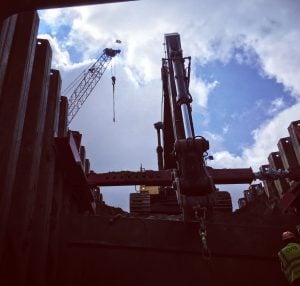Regulatory Differences Between Shoring and Scaffolding
It is not all that uncommon for a scaffold equipment supplier to also be a shoring equipment supplier. After all, both are used on a temporary basis, have similar components and are designed to support loads. While shoring equipment normally supports heavier loads, scaffold frames can as easily be used as shoring as shoring can be used as scaffolding. (The shoring referred to here is the equipment that is used to either support fresh concrete while it is curing (getting hard) or to support existing structures. It is not the equipment used to restrain soil in excavations and trenches.)
Of particular interest are the applicable regulations for scaffolding and shoring. Is shoring the same as scaffolding? Do the regulations that apply to scaffold erectors also apply to shoring erectors? After all, frame scaffold is just like frame shoring—or is it? These are good questions that deserve accurate answers. The quick, or fundamental answer, is that scaffolding is not shoring and shoring is not scaffolding. Since the work activity, and not the equipment, describes the equipment’s function, it just doesn’t matter if scaffold frames are used to shore up concrete any more than if shoring frames are used to support a work platform.
Applying Federal OSHA standards
Here is how the federal OSHA standards get applied. It is necessary to determine what the elevated platform/deck is being used for. Is this elevated platform used to support employees or materials or both so that the workers can reach the work area? For example, are the employees masons who are laying up brick and block? If so, then the elevated platform, and the supporting structure, is a scaffold. On the other hand, is the primary purpose of the elevated platform to support fresh concrete? If so, then the deck is a “horizontal walking/working surface.” The significance here is that the purpose of the deck must be known so that the correct standards are utilized. What happens when the work surface is used to support employees who are using it to reach a work area and the work surface is also being used to support concrete? What about the walkway around the perimeter of the deck that is used to support concrete? Well, here is how it works: Say that you have an electrician using the deck/platform to reach a location to install conduit and electrical boxes. Since the electrician is using the work surface as a scaffold platform, the platform must be able to support itself and four times the intended load. In addition, the guardrails must comply with the scaffold standards, there must be access in compliance with the applicable scaffold standards and any exposed employees must be protected from falling objects.
On the other hand, if the work surface is being used to support concrete, then it must comply with the applicable fall protection, access and formwork standards that address that work activity, including the concrete and formwork standards, 29 CFR 1926, Subpart Q, the fall protection standards at 29 CFR 1926, Subpart M, and the access requirements found at 29 CFR 1926, Subpart X. Typically, if these standards are met, then in the example where the electrician is using the platform to access her work, she will also be in compliance with the scaffold requirements due to the fact that the scaffold regulations are generally not as restrictive as the fall protection and access regulations for working surfaces.
Where are the Differences?
Where are the differences? For the guardrails, in scaffolding the guardrail height is 38 inches to 45 inches while for an open-sided work surface the range is 39 to 45 inches. Access in scaffold requires that the first step is not more than 24 inches while it is 19 inches for a floor or other work surface. Falling object protection standards are similar for both scaffold platforms and other work surfaces although the safety factor for a scaffold platform is 4 while the safety factor for a deck supporting concrete is whatever the employer feels is correct. (ANSI and the SSFI recommend a 2 to 3 safety factor.)
What should be done with erectors? While the temptation is to consider shoring equipment erectors to be the same as scaffold erectors, and therefore the scaffold standards should apply, the reality is that shoring erectors are not scaffold erectors. Consequently, the scaffold regulations do not apply. This presents a quandary when it comes to the application of the appropriate standards. Is climbing a shoring frame access or a working surface? When do shoring erectors use personal fall protection? Or do they?
Well, here is how federal OSHA views it. A shoring frame is a vertical walking/working surface. Consequently, personal fall protection is required when climbing a frame. Standing on a plank at the top of a shoring tower is considered to be an open-sided platform; fall protection is required. Walking/climbing between shoring towers is not normal access so therefore the access standards would not apply. But the fall protection standards would apply.
As for the walkway around a formwork deck supporting concrete, it is considered an open-sided horizontal work surface. Therefore a guardrail system is expected and it must comply with the regulations in Subpart M where the toprail must be at least 39 inches above the deck and no more than 45 inches.
Focus on Purpose and Safety
Confused? The bottom line is that you need to look at the purpose of the work surface. This will determine if it is a scaffold platform rather than a horizontal work surface. And as for the employees installing the rebar and inserts in preparation for placing the concrete, although they appear to be using that deck to access their work and consequently it appears it would then be a scaffold platform, these employees are doing work to the deck which then makes that deck an horizontal work surface and not a scaffold.
Still confused? Focus on safety—not the regulations.












